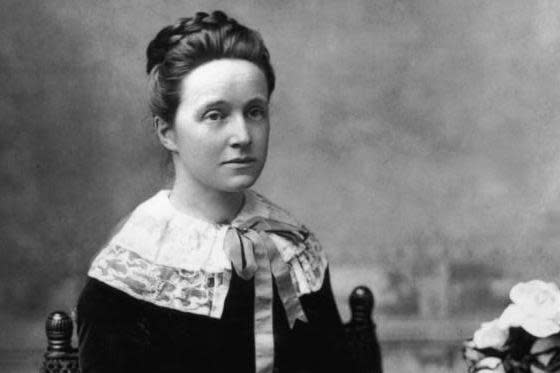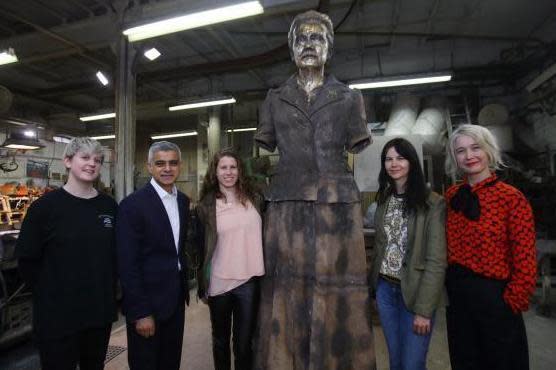Millicent Fawcett: Who is the leading suffragist behind first female statue in Parliament Square?

The first statue of a woman in Parliament Square has been unveiled today two years after a campaign to get female representation outside the Palace of Westminster began.
The bronze statue of Millicent Fawcett joins 11 all-male statues including Sir Winston Churchill, Nelson Mandela and Mahatma Gandhi.
The unveiling on Tuesday came seven months after the statue, which features a 50-year-old suffragist Fawcett holding a banner reading "Courage calls to courage everywhere", first went into production.
Ms Fawcett was considered to have been a instrumental force in getting the women’s vote and ultimately paving the way for female politicians and female Prime Ministers.
Speaking before the unveiling Mayor of London Sadiq Khan said: "When you think of the great people in Parliament Square and when you realise that not one of them is a woman, it sort of begs the question, are we saying there haven't been incredible women in the past? That our country hasn't been built on the back of great women?"
Here's everything you need to know about the Millicent Fawcett.

Background
Millicent Garrett was born in 1847 in Aldeburgh, Suffolk, to entrepreneur and his wife. She was the eighth of ten children and biographers have previously written that the family had a happy home “in which children were encouraged to be physically active, read widely, speak their minds, and share in the political interests of their father, a convert from Conservatism to Gladstonian Liberalism”.
In 1858, aged 12, she was sent to boarding school in in Blackheath, London, where she relished studying literature.
She was not the only pioneering woman to emerge from her family - her sister Elizabeth Garrett Anderson went on to become the first female doctor in the UK.

Early campaigning
According to historians, a pivotal moment in the young women’s life came when she went to hear MP Joh Stuart Mill speak at the age of 19.
Mr Mill – a radical politician – supported female suffrage and equal rights for women and his address in 1866 had a big impact on Ms Fawcett.
Her and a group of young women, including her sister and suffragist Emily Davies, formed the Kensington Society - a discussion group focused women's suffrage. Together they organised signatures for the first petition for women's suffrage.
Throughout her campaign work she met with other prominent activists including Brighton MP Henry Fawcett who would later become her husband.

Ms Fawcett - now going by the name Millicent Garrett Fawcett - became an influential writer. Her first book ‘Political Economy for Beginners’ was published in 1870 and well-received.
And her and her husband continued to be prominent campaigners in the battle for women’s education at Oxford University.
After her husband’s death in 1884 Ms Fawcett – who was just 38 – devoted more her time to political campaigning.
NUWSS
In 1890 Ms Fawcett was elected president of the National Union of Women’s Suffrage Societies which was the leading group in campaigning for the women’s vote.
The suffragist organisation, under Ms Fawcett, campaigned for female suffrage as well as a myriad of humanitarian issues including the abolition of the slave trade and funding for overseas aid.
The NUWSS believed in fighting for the vote through peaceful and constitutional means. Ms Fawcett believed that by demonstrating that women were intelligent, law-abiding citizens then they would be seen to be responsible enough to participate fully in politics.
During the Liberal Government who led the country between 1901 and 1914, there was increasing frustration at the lack of progress.
This sparked action taken by the militant suffragettes – who were in support of more extreme tactics including violence and, when jailed, hunger strikes.
The contrast between the two approaches caused a deep divide in the women’s movement.
This was enhanced when the war broke out in 1914 and suffragette Emmeline Pankhurst publicly supported the conflict – encouraging men to sign up.

The suffragists, however, were largely pacifists and in favour of international peace treaties. When Ms Fawcett spoke out to say that she also, in fact, supported the war, writing “women: your country needs you”, many campaigners quit the NUWSS, damaging the movement.
Success
Despite the detrimental divisions and conflict plaguing the women’s suffrage movement, the female effort in the First World War was widely acknowledged and it became more accepted that women should have the right to vote.
In 1918, the ‘Qualification of Women Act’ was passed – giving women over the age of 30 the vote. To qualify, you had to be over 30 years old and hold £5 of property, or have a husband who did.

Shortly after the act was passed, the NUWSS was disbanded and Ms Millicent retired from active engagement in politics.
She was appointed a Dame Grand Cross of the Order of the British Empire (GBE) in the 1925 New Year Honours.
In 1928, voting rights were extended to all women over 21, in line with men, and an 81-year-old Fawcett watched on in the public gallery in the House of Commons as the bill was passed.
“It is almost exactly 61 years ago since I heard John Stuart Mill introduce his suffrage amendment to the Reform Bill on May 20th, 1867. So I have had extraordinary good luck in having seen the struggle from the beginning,” she later wrote.

A year later, she died.
She is considered to have been a instrumental force in getting the women’s vote and ultimately paving the way for female politicians and female Prime Ministers.
Today, the Fawcett Society, named in her honour, continues to fight for gender equality and in February this year Fawcett won a BBC Radio 4 poll for the most influential women of the past 100 years.

 Yahoo News
Yahoo News 
